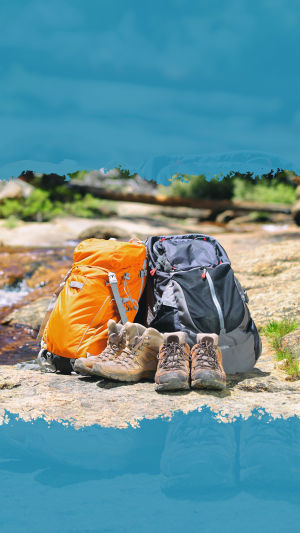This article will give you six suggestions for a trekking essentials checklist. Bring these important items with you, and your travel experience can be better guaranteed. Before you go, check your belongings list to make sure nothing important is missing.
Then come back from each trip and review your list to improve your inventory based on the experience and feelings of the trip.
1. Navigation system
When it comes to hiking in the wild, the importance of a navigation system cannot be overstated. If you've ever lost your way, you know how important it is. In critical moments, it can even save your life. Navigation systems include maps, compasses, GPS devices, walkie-talkies, etc.
Even if you have technical equipment like GPS to guide you to your destination, it is still necessary to carry a map and a compass. GPS may be out of power or lose signal, at this time, traditional maps and compasses can help you know the exact location, the direction you are heading, and calculate the distance on foot.
2. Sunscreen
Sun protection is also quite important, especially in summer. Protect your eyes and skin from direct UV rays, as strong UV rays can cause sunburn and even skin cancer. Sunglasses, sun hats and sunscreen are a must. At the beginning of the hike, do physical sunscreen first, and then add chemical sunscreen.
In addition to the most important face and neck, don't forget to apply sunscreen on your hands. Also remember to supplement sunscreen in time according to travel time, sweating and other factors.
3. Emergency Shelters and Rain Protection
A rain cover and shelter is a must when backpacking. The weather can change at any time, and a high-quality waterproof raincoat can protect you in heavy rain. The next thing to consider is a lightweight tarp or tent.
Without these, it will be difficult to survive stormy or rainy nights. So make sure to keep the tarp on the bottom of the pack as this may help in an emergency.
4. First aid kit
The first aid kit is also an essential item in the backpack. With the first aid kit, there is a basis for rescue. Bandage, hemostatic patch, iodine, medical gauze, medical tape, knife, etc. It is also best to prepare some medicines, such as painkillers, antidiarrheal medicines, heatstroke medicines, high hair medicines, etc.
At the same time, according to personal physical conditions, bring personal medicines with you.
5. Water purification device
During long-distance hiking, if you need to rely on the water source on the way, it is best to bring a water purification device. If you cannot afford a water purification device or it is inconvenient to carry, you can bring some drops to purify the water.
Without enough water, the body will not function properly and can even lead to altitude sickness, heat stroke and hypothermia. There is no purified water in the wild, there may be microorganisms, and drinking it will cause diarrhea, or even more serious problems, affecting the hiking experience.
If there is no such thing, be sure to boil the water before drinking.
6. Extra clothes
If it is mountaineering, the temperature will decrease as the poster rises, and the mountain climate is unstable, and it is easy to encounter unexpected weather. It is necessary to have extra clothes. Choose the right clothing and the best boots for the terrain you will be hiking outdoors.
Even on a short trip, changing into a dry suit at the end can add to the comfort of the entire trip. In short, bring extra clothes and pack wisely after learning about the different climatic conditions in your hiking area.





